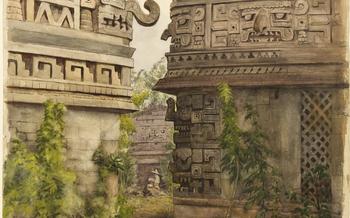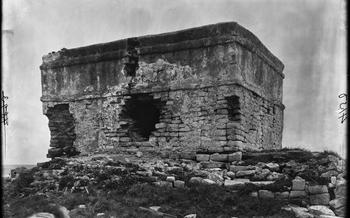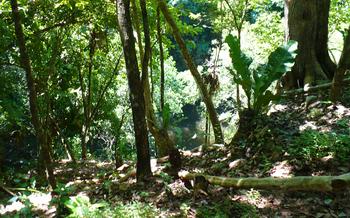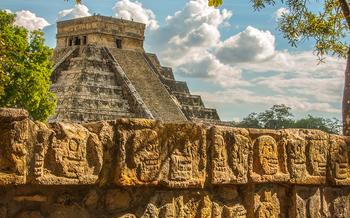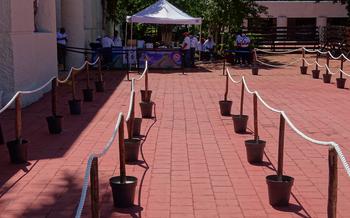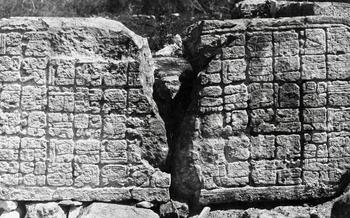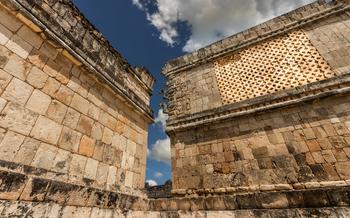
Cenote Hubiku
- A Paradise Called Cenote Hubiku:
- Mesmerizing Views
- Swimming and Snorkeling
- Ancient History and Mayan Legends
- Unique Flora and Fauna
- Sunbathing and Relaxation: Finding Tranquility at the Cenote's Edge
- Authentic Mayan Cuisine
- Cultural Workshops and Activities
- Sustainable Tourism Practices
- Photography and Instagrammable Moments
- Off-the-Beaten-Path Adventures
- Local Festivals and Events
A Paradise Called Cenote Hubiku:
In the heart of Mexico's vibrant Yucatán Peninsula, nestled amidst lush greenery and ancient Mayan ruins, lies a hidden gem known as Cenote Hubiku. This natural wonder is a breathtaking sinkhole, formed by the collapse of limestone bedrock, revealing a crystal-clear cenote. Its turquoise waters, surrounded by lush vegetation and unique rock formations, create a picturesque scene that will leave you spellbound.
Theoretical Notions: A cenote is a natural pit or sinkhole that results from the collapse of limestone bedrock, exposing groundwater underneath. These unique geological formations are found in abundance in the Yucatán Peninsula, where the limestone bedrock is highly porous and susceptible to erosion by water. For the ancient Mayans, cenotes were considered sacred places, believed to be portals to the underworld and a source of fresh water.
Practical Suggestions: Reaching Cenote Hubiku is a relatively easy task. From the city of Cancún, you can take a short drive or hop on a guided tour that will take you directly to the site. Be sure to bring comfortable swimwear, a towel, sunscreen, and a camera to capture the stunning scenery. When visiting the cenote, remember to respect the natural environment and avoid disturbing the wildlife.
Anecdotes: I had the privilege of visiting Cenote Hubiku during a solo trip to the Yucatán Peninsula. As I descended the wooden staircase leading to the cenote, I was greeted by a breathtaking view. The crystal-clear water sparkled in the sunlight, reflecting the vibrant colors of the surrounding vegetation. I couldn't resist taking a dip in the refreshing waters, where I was surrounded by a kaleidoscope of fish and the gentle sound of dripping water. It was a truly unforgettable experience that left me feeling rejuvenated and in awe of nature's beauty.
Mesmerizing Views
The Cenote Hubiku offers a visual feast to behold, captivating visitors with its awe-inspiring beauty. The crystal-clear waters, a symphony of turquoise and emerald hues, invite you to plunge into their depths and explore the underwater world. Lush vegetation surrounds the cenote, creating a verdant oasis that provides shade and tranquility. Gaze upon the unique rock formations that adorn the cenote, each one telling a story of the geological forces that shaped this natural wonder.
Theoretical Notions: Cenotes are formed through the collapse of limestone bedrock, creating sinkholes that fill with water. The process of water erosion, caused by the flow of underground rivers, carves out these natural pools, giving rise to the distinctive features of a cenote.
Practical Suggestions: - Arrive early in the morning or late in the afternoon to capture the best photos, when the sunlight illuminates the cenote's waters, casting dramatic shadows and enhancing the colors. - Use a waterproof camera or housing to capture stunning underwater shots of the cenote's vibrant marine life. - Experiment with different angles to create unique perspectives, such as shooting from above or below the water's surface.
Anecdotes: - I remember my first glimpse of the Cenote Hubiku, a moment that took my breath away. The vibrant colors of the water, the lush greenery, and the towering rock formations combined to create a scene that seemed too beautiful to be real. - During a snorkeling session, I was mesmerized by the intricate patterns formed by the sunlight filtering through the water's surface, casting a golden glow on the underwater world. It was a truly magical experience.
Swimming and Snorkeling
The crystal-clear waters of the Cenote Hubiku offer an incredible opportunity for swimming and snorkeling. Immerse yourself in the refreshing waters and marvel at the breathtaking underwater world that awaits. The cenote is home to a diverse array of aquatic life, including colorful fish, majestic turtles, and other fascinating creatures. Snorkeling enthusiasts can rent gear on-site and explore the depths of the cenote, discovering its hidden underwater caves and tunnels. Choose the best time to visit for optimal visibility, typically early morning or late afternoon, and remember to stay safe while swimming by following the guidelines and wearing appropriate safety gear.
Ancient History and Mayan Legends
The Cenote Hubiku holds immense cultural significance as a sacred site for the ancient Mayans. Steeped in mystery and intrigue, it has inspired countless legends and stories passed down through generations. The Mayans believed that cenotes were portals to the underworld, Xibalba, where the gods dwelled and the spirits of the deceased journeyed. According to Mayan mythology, the cenote was a place of communication with the divine, where shamans and priests performed rituals and ceremonies to connect with the spirit world.
Theoretical Notions:
- The Mayans held a deep reverence for cenotes, considering them sacred and imbued with spiritual energy.
- Cenotes were believed to be gateways to Xibalba, the Mayan underworld, where the gods resided and the souls of the deceased traveled after death.
- Mayan rituals and ceremonies often involved offerings to the gods and requests for guidance and protection, which were believed to be more effective when performed at cenotes.
Practical Suggestions:
- Visitors can enhance their experience by learning about Mayan history and mythology before visiting the cenote.
- Guided tours often provide insights into the cultural significance of the cenote and the rituals associated with it.
- Respecting the sacred nature of the cenote is essential, and visitors should refrain from loud noises or disruptive behavior.
Anecdotes:
- During my visit to the cenote, I had the opportunity to speak with a local Mayan guide who shared fascinating stories about the legends and rituals associated with the site.
- He described how the Mayans believed that the cenote was a place where the veil between the worlds was thin, allowing for communication with the spirits.
- The guide's stories brought the ancient Mayan culture to life and deepened my appreciation for the spiritual significance of the cenote.
Unique Flora and Fauna
The Cenote Hubiku is home to a diverse ecosystem, teeming with unique plant and animal species that have adapted to this extraordinary environment. The cenote's crystal-clear waters support a variety of aquatic life, including colorful fish, graceful turtles, and even the occasional crocodile. Above ground, the lush vegetation surrounding the cenote provides a habitat for numerous bird species, including vibrant parrots, majestic eagles, and tiny hummingbirds.
In the depths of the cenote, intricate cave systems provide shelter for bats, spiders, and other subterranean creatures. The cenote's unique environment has also fostered the growth of specialized plant species, such as ferns and mosses, which thrive in the humid conditions.
Observing and identifying the diverse flora and fauna of the Cenote Hubiku is a rewarding experience for nature enthusiasts. With a keen eye and a little patience, visitors can witness the intricate relationships between the different species and gain a deeper appreciation for the delicate balance of this unique ecosystem.
Sunbathing and Relaxation: Finding Tranquility at the Cenote's Edge
The Cenote Hubiku offers a serene sanctuary for those seeking tranquility and rejuvenation. Its picturesque surroundings create an idyllic setting for sunbathing and relaxation. Visitors can bask in the warm sunshine, lulled by the gentle murmur of the cenote's waters. Finding the perfect spot to unwind is easy, with plenty of sunbathing areas to choose from. Whether it's on the soft sand by the water's edge or in a secluded hammock nestled among the lush vegetation, visitors can find their own private haven of relaxation.
Spending time in nature has been proven to have numerous benefits for our well-being. It reduces stress levels, improves mood, and enhances overall mental health. The Cenote Hubiku provides a perfect opportunity to connect with nature and experience its restorative powers. As you soak up the sun and breathe in the fresh air, you'll feel your worries melt away, leaving you refreshed and revitalized.
To make the most of your sunbathing experience, it's important to stay hydrated and protected from the sun's harmful rays. Bring plenty of water and choose a sunscreen with a high SPF to prevent sunburn. Remember to reapply sunscreen regularly, especially after swimming or sweating.
At the Cenote Hubiku, sunbathing is more than just a pastime; it's an opportunity to embrace the beauty of nature and find inner peace. Let the cenote's serene atmosphere soothe your senses as you relax and rejuvenate in this natural paradise.
Authentic Mayan Cuisine
The Cenote Hubiku is surrounded by a variety of local restaurants and eateries that serve authentic Mayan cuisine. Visitors can indulge in traditional dishes like cochinita pibil, a slow-roasted pork dish cooked in achiote paste, and papadzules, corn tortillas filled with eggs, black beans, and pumpkin seeds. Fresh tropical fruits like papaya, mango, and pineapple are also a must-try.
The traditional Mayan diet is based on corn, beans, and chili peppers. Mayans have a unique way of cooking that involves using a traditional wood-fired oven called a pib. This cooking method gives food a smoky flavor that is characteristic of Mayan cuisine.
When choosing a restaurant, look for places that use fresh, local ingredients and traditional cooking methods. It is also a good idea to ask for recommendations from locals or your hotel concierge.
One of my favorite dining experiences at the Cenote Hubiku was at a small, family-run restaurant called "El Rincon Maya." The food was delicious, and the atmosphere was warm and inviting. I highly recommend trying their cochinita pibil, which was the best I've ever had.
Cultural Workshops and Activities
The Cenote Hubiku offers a unique opportunity to immerse yourself in the vibrant culture of the Maya. Visitors can participate in various workshops and activities that showcase traditional Mayan crafts and traditions. These workshops provide an excellent way to learn about the history, culture, and beliefs of the Maya while creating your own handmade souvenirs.
From learning the art of weaving intricate textiles to creating colorful pottery, there is something for everyone to enjoy. Visitors can also participate in traditional Mayan cooking classes, where they can learn to prepare delicious dishes using fresh, local ingredients. These workshops offer a hands-on experience that allows visitors to connect with the Mayan culture in a meaningful way.
By participating in cultural workshops, visitors not only support local artisans but also contribute to the preservation of Mayan traditions. The workshops are conducted by experienced local artisans who share their knowledge and skills with visitors, ensuring that these traditions continue to be passed down from generation to generation.
Sustainable Tourism Practices
The Cenote Hubiku is committed to sustainable tourism practices, ensuring that its natural beauty and cultural significance are preserved for future generations. Visitors are encouraged to practice responsible tourism by minimizing their impact on the environment and supporting local communities. This includes using biodegradable products, respecting wildlife, and disposing of waste properly. The cenote's management team has implemented several initiatives to promote sustainability, such as reforestation projects and community-based tourism programs. By embracing sustainable practices, tourists can contribute to the preservation of this unique ecosystem and support the local economy.
Photography and Instagrammable Moments
The Cenote Hubiku is a photographer's paradise, offering endless opportunities to capture stunning images. The crystal-clear waters, lush vegetation, and unique rock formations create a picturesque backdrop for your shots. Whether you're a professional photographer or simply looking to capture some memorable moments, the cenote is sure to deliver.
When it comes to photography, composition is key. Experiment with different angles and perspectives to find the most flattering shots. The cenote's natural beauty shines brightest in the morning light, so plan your visit accordingly. Don't be afraid to get creative with your compositions; try incorporating elements like reflections, silhouettes, or leading lines to add depth and interest to your photos.
Of course, no visit to the Cenote Hubiku is complete without a few Instagram-worthy shots. The cenote's unique features make it an ideal location for capturing those envy-inducing travel photos. Whether you're posing for a solo shot or capturing a group photo with friends, the cenote provides a stunning backdrop that will make your photos stand out.
Remember, while capturing those perfect shots, it's important to respect the natural environment. Avoid disturbing the wildlife or damaging the delicate ecosystem. Tread lightly and leave no trace, so that future generations can also enjoy the beauty of the Cenote Hubiku.
Off-the-Beaten-Path Adventures
Venturing beyond the main tourist attractions at Cenote Hubiku leads to a world of hidden gems waiting to be discovered. Explore lesser-known cenotes, each with its unique charm, tucked away in the lush jungle. Embark on a trek through the surrounding jungle trails, spotting exotic birds, colorful butterflies, and maybe even a glimpse of a shy monkey swinging through the trees. Discover nearby villages, where you can interact with the local communities, learn about their traditions, and savor authentic Mayan cuisine. These off-the-beaten-path adventures offer a glimpse into the region's true essence, allowing you to connect with the land and its people in a meaningful way.
Local Festivals and Events
Immerse yourself in the vibrant culture of the region by participating in local festivals and events that showcase the rich traditions of the Mayan people. These celebrations are a kaleidoscope of colors, music, dance, and flavors, offering a glimpse into the heart and soul of the community. From lively parades and traditional ceremonies to food fairs and music concerts, there's something for every traveler to enjoy.
Theoretical Notions:
- Cultural festivals play a vital role in preserving and celebrating the unique heritage of the region.
- Traditional dances, such as the rhythmic Jarana, represent the fusion of Mayan and Spanish influences.
- Mayan cuisine takes center stage, with mouthwatering dishes like cochinita pibil and panuchos tantalizing taste buds.
- Community gatherings foster a sense of unity and belonging, strengthening the bonds between locals and visitors alike.
Practical Suggestions:
- Research upcoming festivals and events before your trip to plan your itinerary accordingly.
- Immerse yourself in the festivities by wearing traditional clothing, learning a few Mayan phrases, and trying local delicacies.
- Respect local customs and traditions by asking permission before taking photos or videos of ceremonies or performances.
- Support local artisans by purchasing handmade crafts and souvenirs at festival markets.
Anecdotes:
- I'll never forget the thrill of watching the vibrant parade during the annual Carnival celebration, where locals and tourists alike danced to the infectious rhythm of drums and maracas.
- The aroma of freshly made tortillas wafted through the air as I savored delicious street food at a local food fair, connecting with friendly vendors who shared stories about their culinary traditions.
- At a traditional Mayan ceremony, I witnessed the mesmerizing dance of the "pastorelas," young girls dressed in colorful costumes, their movements symbolizing the cyclical nature of life.
